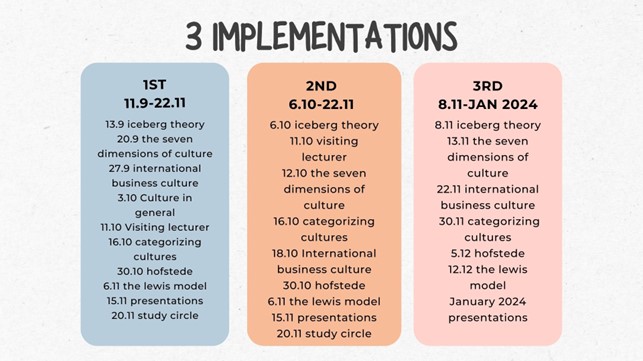
The International Tourism Management degree program faced similar challenges to other international degree programs: it takes time for international students to arrive in Finland, and they come individually throughout the academic year.
We had the opportunity to develop a flexible start concept beginning in autumn 2023, called ongoing enrollment. In this concept, most first-year courses are offered in a way that allows students to start at any time, meaning on the very day they arrive on campus.
Different courses were implemented slightly differently, but the main principle remained the same. The course content was divided into smaller learning objectives. We called these units “themes,” and each course included a certain number of themes, for example, six themes.
Each theme includes a weekly lecture and/or workshop and assignments. After all the themes are covered, a new round of themes begins. In the ongoing enrollment concept, at least two rounds should be conducted per semester.
The system is flexible for students, as they can enroll in the course on any theme. For example, if a student starts a six-theme course at theme 3, they will proceed in order through themes 3, 4, 5, and 6, then in the next round, themes 1 and 2. In addition to the themes, there may be a final exam or assignment, which becomes available to the student after completing most of the assignments from the themes.
The concept is described in the course ”Introduction to Tourism and Hospitality Business” as follows: “The first round of this course begins in week 36 and includes weekly on-campus classes. Each week focuses on a specific theme – there are six themes in total – comprising classes, workshops, and Moodle quizzes. In addition to these six themes, there is a final Moodle test and a blog writing assignment. After six weeks, the themes cycle starts anew. If you miss a theme, you can retake it in the next round. Please note that quizzes and assignments cannot be redone.”
The ongoing enrollment concept can be implemented in various ways. The picture below (Huuhka 2024) is an example from the course Cultural Competence as a Success Factor, which had three rounds during the fall semester 2023. In this implementation, the second round and first round lectures were partly joint. For example, “categorizing cultures,” “Hofstede,” “the Lewis Model,” and “study circle” were the same for both rounds.

Attention should be given to learning objectives, teaching content, teaching methods, assessment criteria, and feedback as in any other courses. It is also recommended to create a core content analysis to support teaching and help students set their own learning goals.
Positives:
• Students can start their studies immediately after arriving on campus without any waiting.
• Developing a new pedagogical solution is rewarding for teachers.
• The ongoing enrollment concept is also flexible for teachers.
• Students easily adopted and understood the concept.
Points to Consider:
• Teaching many rounds felt repetitive for the teachers.
• Students were confused about courses that were not in ongoing enrollment.
• The concept and Moodle platform need to be clear and accessible.
• Teachers should be careful with allowing retakes of assignments in this concept.
• The timetable and flexible start model don’t work fluently together yet.
• Teachers need to give grades regularly and consider carefully how students request their grades.
• Not all elements of the concept had established pedagogical terms.
Text: Senior Lecturers Jonna Huuhka and Jaana Ruoho
Artcle photo: Inna Saarinen
We used the help of ChatGPT in the translation process from Finnish to English.